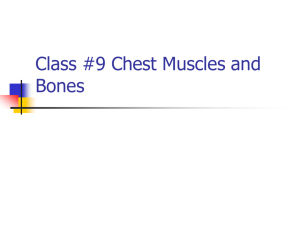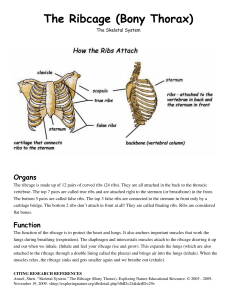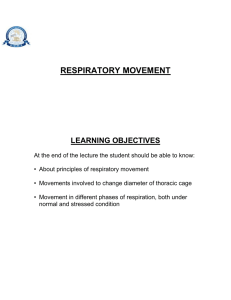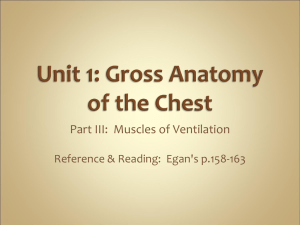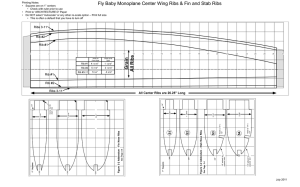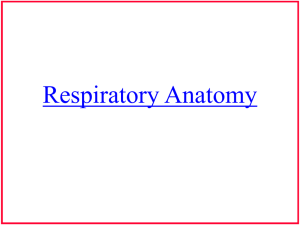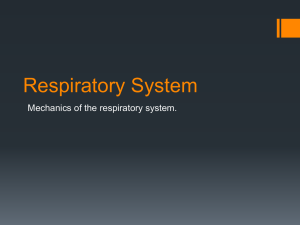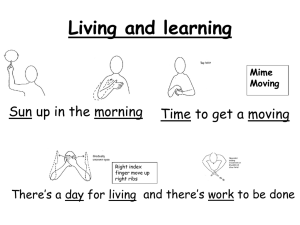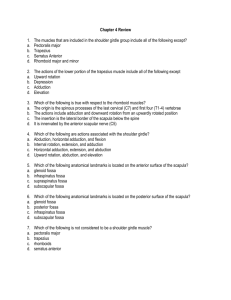Chapter 3 Anatomy of Respiration
advertisement
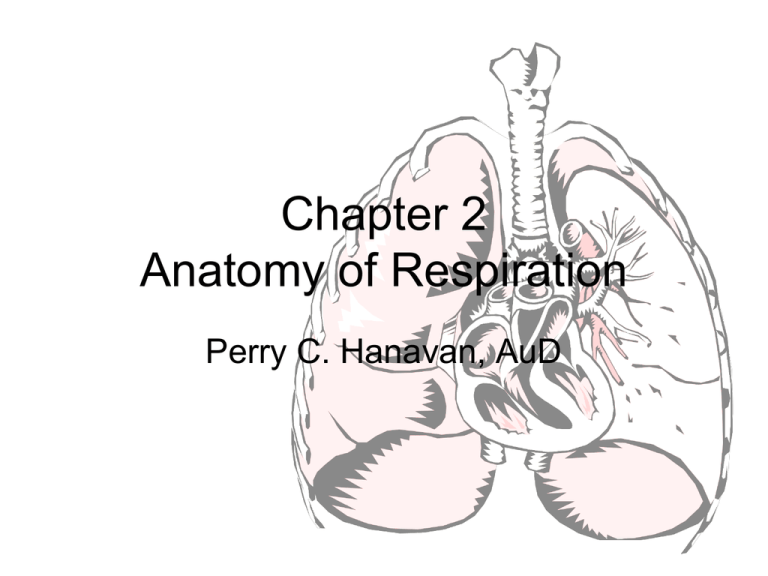
Chapter 2 Anatomy of Respiration Perry C. Hanavan, AuD Vertebral Column • • • • Vertebrae (video) Vertebral column Vertebrae Cervical – Atlas and Axis • Thoracic – 12 pair of ribs articulate • Lumbar • Sacral • Coccyx Vertebra Question Which of the following best describes curvature of the spine away from the midline or sideways? A. Kyphosis B. Lordosis C. Scoliosis D. None of the above SMART Response Que To set the properties right click and select SMART Response Question Object->Properties... Vertebral Disorders Kyphosis Lordosis Scoliosis Vertebral Disorders Disc Problems Vertebral Disorders Question How many ribs do humans normally have? A. 12 B. 24 C. 16 D. Varies from human to human E. Adam is missing one SMART Response Que To set the properties right click and select SMART Response Question Object->Properties... Ribs • Bony thorax (anterior view) • Bony thorax (posterior view) • 12 pair of ribs: – True Ribs – ribs 1-7; these are attached directly to the sternum through their own costal cartilages. – False Ribs – ribs 8-10; their costal cartilages are joined to the rib just above them so their attachment to the sternum is indirect – Floating Ribs – ribs 11-12; these ribs attach to vertebrae, but not to the sternum so they float on one end Rib Cage During Respiration • • • • Dr. Michael Parker Demo Dr. Michael Parker Demo2 Dr. Michael Parker Demo3 Rib Question Term that means breastbone? A. Corpus B. Xiphoid C. Sternum D. Clavicle SMART Response Que To set the properties right click and select SMART Response Question Object->Properties... Sternum • Sternum (breastbone) – Manubrium - handle – Corpus - body – Xiphoid - sword • Rib and clavicular articulations Scapula • Scapula – shoulder blade Clavicle • Clavicle – collar bone Pelvis • Pelvic girdle - basin Question If a person where to aspirate an object, it is most likely to fall into this lung: A. Right B. Left C. Depends on age of person D. Equal odds falling into either SMART Response Que To set the properties right click and select SMART Response Question Object->Properties... Lungs • Lungs – 2 lungs • Right – 3 lobes • Left – 2 lobes – Mediastinum • Cardiac notch Question Two terms mean windpipe…one Latin and the other Greek (select 2 answers) A. Trachea B. Bronchi C. Alveoloi D. Larynx SMART Response Que E. Pharynx To set the properties right click and select SMART Response Question Object->Properties... Lungs Bronchial Passageway • • • • • Trachea Bronchi Secondary bronchi Tertiary bronchi Alveoli Trachea and Bronchi • Trachea – • Bronchi – • Alveoli -O2 and Co2 are exchanged at the alveoli. There are about 300 million alveoli which are encapsulated in capillaries. The surface of the alveolus is composed of a thin layer of squamous epithelial cells with cuboidal cellsinterspersed among them. Pleural Linings • Thoracic linings – parietal pleurae • Mediastinal pleura • Pericardial • Diaphragmatic • Costal • Apical • Visceral Muscles of Inspiration • • • • • • • • • • • • • • • Diaphragm External intercostal Internal intercostal Levator costarum Serratus posterior superior Sternocleidomastoid Scalenus Trapezius Pectoralis major Pectoralis minor Serratus anterior Subclavius Levator scapulae Rhomboideus major Rhomboideus minor Diaphragm • Dome shaped muscle innervated by two phrenic nerves. • When diaphragm contracts during normal breathing, the dome descends l-2 cm and as much as l0 cm during deep inspiration. Intercostals Intercostals Neck Muscles Neck Inspiratory Muscles Anterior • Pectoralis • Serratus anterior • Subclavius Anterior Inspiratory Muscles Posterior Muscles • Levatores costarum • Serratus posterior superior • Levator scapulae • Rhomboideus • Latissimus dorsi Posterior Inspiratory Muscles Posterior Muscles of Inspiration Muscles of Expiration • • • • • • • • • • Internal intercostal Transversus thoracis Subcostal Serratus posterior inferior Innermost intercostal Latissimus dorsi Internal oblique abdominis External oblique abdominis Rectus abdominis Quadratus lumborum Anterior Expiratory Muscles Anterior Expiratory Muscles End Chapter 2 Study
